- Home
- Sustainability
- Social
- Social Contribution
- Examples of Social Contribution Activities in Japan
Examples of Social Contribution Activities in Japan
- Mt. Fuji Manabi no Mori Project
- Tree Planting Activity Oku Matsushima Nature Recovery Volunteer
- Cooperation with Local Communities
- Technology to Pass Down Heritage and Precious Trees to the Next Generation
- Training and Education for the Next Generation
- Support for Social Contribution Activities of Other Companies
- Dissemination of SDGs
Mt. Fuji Manabi no Mori Project
We are continuing the Mt. Fuji Manabi no Mori Project which began in 1998 to commemorate the 50th anniversary of Sumitomo Forestry's establishment, setting out to restore the vitality of the rich national forest cloaking the foothills of Mt. Fuji that was extensively damaged by a typhoon. Currently, this project is visualizing the progress of tree growth in survey areas of planted regions and overseeing natural forest recovery of Mt. Fuji Manabi no Mori.
In fiscal 2024, Mt. Fuji Manabi no Mori was used for volunteer activities and environmental education programs. Approximately 1,600 people visited Mt. Fuji Manabi no Mori from inside and outside of the Company. The cumulative number of visitors has now reached approximately 38,000.
- Click here for related information
Volunteer Activities in Forestry Development
Since the start of the project in 1998, approximately 30,000 region-specific saplings have been planted so far. In total, more than 12,000 volunteers have participated in tree planting and cultivation activities.
To date, reforestation efforts of national forest damaged by typhoons were completed as the first phase by removing the hexatubes. In fiscal 2019, a tree survey began as a monitoring survey necessary to comprehensive forest management activities. In 2024, as the sixth year of this tree survey, approximately 70 volunteers took part in creating a database from records of 447 trees planted on an area of approximately 1,800 m2.
The Manabi no Mori project will shift to a more friendly forest suitable for learning by visualizing the growth of the trees that have been planted by the volunteers so far. Cultivating a forest is long-term commitment. Therefore, the Mt. Fuji Manabi no Mori project is designed as a 100-year initiative. To ensure that the project will still be running 100 years from now, comprehensive forest management and environmental activities will be continued as a way to communicate the importance of nature to as many people as possible.
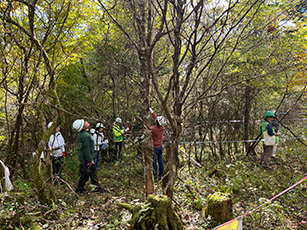
Volunteer tree survey
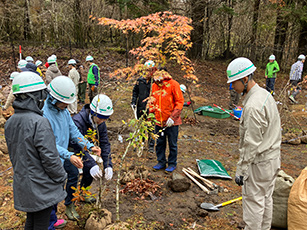
Group Photo of Employee Volunteers
Environmental Education Program
Sumitomo Forestry has been implementing an Environmental Education Program for local elementary and junior high school students since fiscal 2006 in collaboration with the NPO Whole Earth Institute (currently Whole Earth Nature School). Activities include nature observation, looking for tracks and traces of wild animals, and games incorporating the five senses. The aim of these activities to rediscover the natural world is for the students to learn about the importance of nature and encourage them to consider new ways in which people can coexist with nature in the future. In fiscal 2024, a total of 1,167 students and children from 17 schools were invited to the program. A cumulative total of more than 15,000 students and children have been invited as of fiscal 2024.
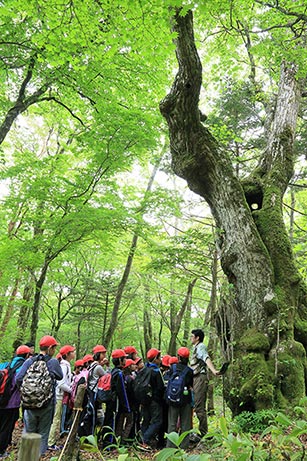
Environmental Education Program
Environmental Education Program Trend
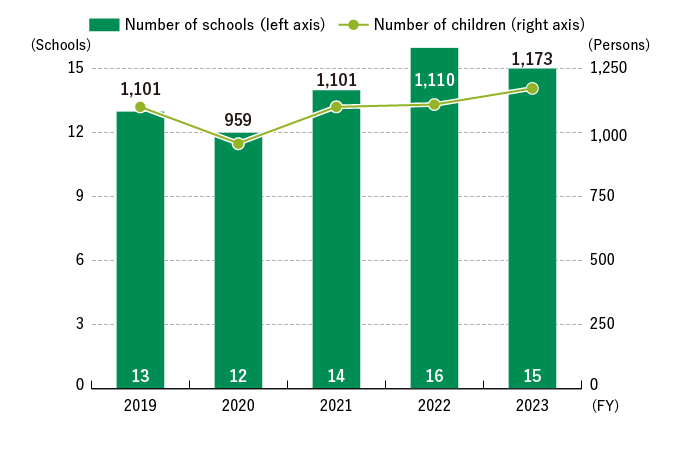
Monitoring Survey
At Mt. Fuji Manabi no Mori, we are monitoring and researching the recovery of the natural forest. We have been conducting vegetation surveys since fiscal 2000 with the cooperation of Vegetation Management Science Laboratory, Tokyo University of Agriculture and Technology. Since the same year, we have also been conducting wildlife habitat surveys with the cooperation of the Minami Fuji Branch of the Wild Bird Society of Japan. In addition, since 2019, the insect habitat surveys have been conducted with the cooperation of a professor emeritus from Tokoha University. The results of these surveys will be used to continue future forestry activities.
Vegetation Surveys
The vegetation monitoring has been able to confirm the gradual growth of beech, Japanese zelkova, and other trees that were planted, as well as dogwood and other species that grew naturally after the damage caused by the typhoon in 1996. In 2024, the expansion of the trunks of tall tree species and a decline in the shrub layer were observed. It can be said that we have now entered a phase of competition for space among tall tree species, and we will continue to monitor this.
Wildlife Habitat Survey/Insect Habitat Survey
The wildlife habitat survey found that the environments where the ground was bare after the removal of fallen trees gradually transformed from grasslands to forests. And the populations of grassland birds, such as pheasants and shrikes, declined, but opportunities to observe forest birds like narcissus flycatchers and various tits increased. This survey, conducted four times a year since 2000, reached its 100th anniversary in February 2025. We will continue to monitor the steady recovery of the forest through the ecology of birds, mammals, and other wildlife.
Since 2019, we have conducted a three year "insect habitat survey" (not conducted in 2021 due to unfavorable weather conditions). The three-year survey found that there was no significant difference in the number of insect species observed between the natural forest and the planted areas, suggesting that the planted areas are steadily transitioning toward natural forest. We are currently reviewing the survey methods to ensure that regular monitoring can continue in the future.
Vegetation Shift in the Wind-afflicted Area
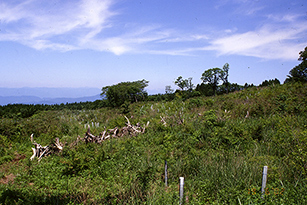
(2001)
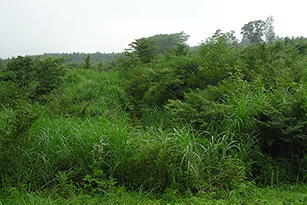
(2008)
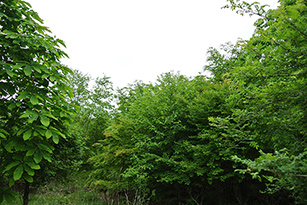
(2016)
- Click here for related information
Tree Planting Activity Oku Matsushima Nature Recovery Volunteer
Sumitomo Forestry entered into a partnership agreement on restoration property development coordination and cooperation with Higashi Matsushima City, Miyagi Prefecture in 2012 after the Great East Japan Earthquake to make every effort toward restoration. Higashi Matsushima City aims to revitalize tourism by bringing back the wetlands in the Suzaki district near the Nobiru coast devastated by the tsunami. As part of this effort, Sumitomo Forestry began trial tree planting activities in fiscal 2017. A soil investigation discovered a high concentration of acidity, which needed considerations about the tree species and techniques for planting. We then formulated a tree-planting plan taking into account third-party insight from the Tohoku Research Center of the Forestry and Forest Products Research Institute. We checked and made sure the seedlings had been growing with support by the local community, thus we have started the Oku Matsushima Nature Recover Volunteer Planting Activity along the Nobiru coast of Higashi Matsushima City since fiscal 2019.
In 2024, a total of 200 people participated in the tree planting. Local residents, children from Higashi-Matsushima Municipal Miyanomori Elementary School, Sumitomo Forestry's subcontractors, and Sumitomo Forestry Group employees worked together to plant 850 plants from five local indigenous species. In addition to the tree planting, this volunteer activity included clearing the underbush so that the seedlings in the planted area would grow to a large size. We also provided environmental education to third-year students of Miyanomori Elementary School, and are working to grow Raphiolepis umbellata, a local indigenous plant, until it becomes a seedling plant from seedings. We are working together with the local community on medium- to long-term activities.
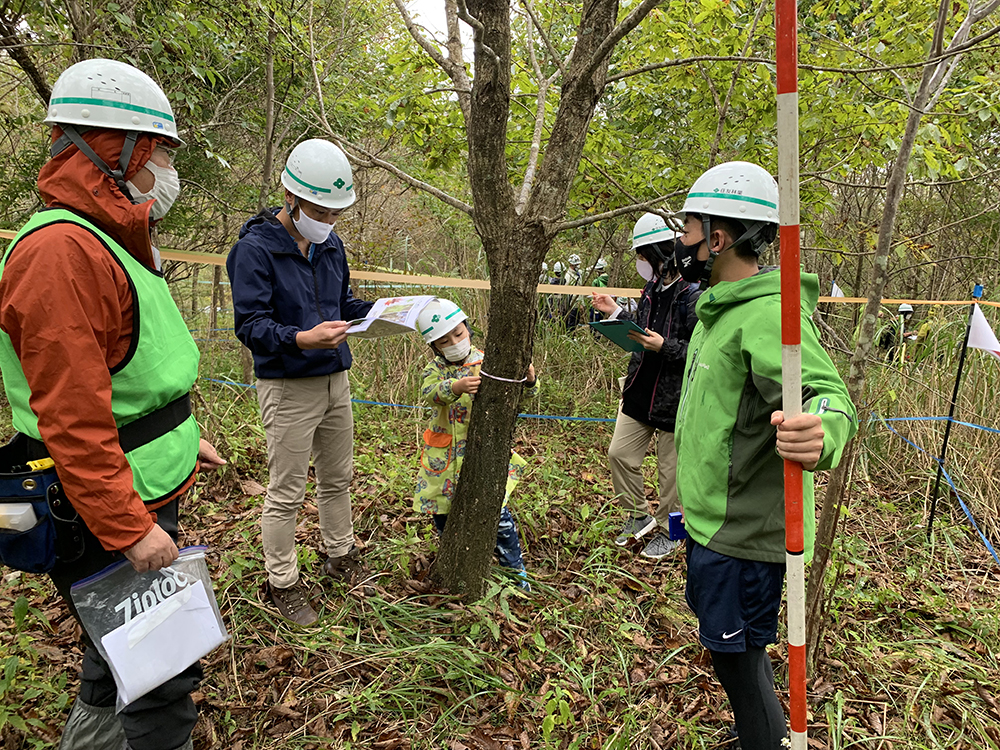
Group photo of tree planting activities
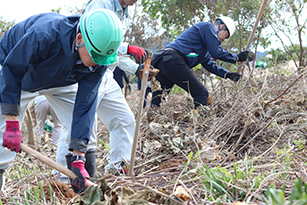
Tree Planting
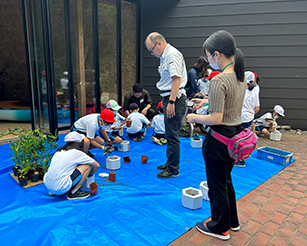
Environmental education at Miyanomori Elementary School
Cooperation with Local Communities
The Sumitomo Forestry Group conducts biodiversity conservation in surrounding areas where it engages business in and conducting and activities tied to local communities with local residents.
Implementation of "Ehime Prefecture "Ai-Road" Supporter" Activities
In 2019, Sumitomo Forestry was certified as a model supporter under the "Ehime Prefecture "Ai-Road" Supporter Business", which supports voluntary cleanup and beautification activities by Ehime prefectural government. Every spring and summer, Sumitomo Forestry Group companies in Niihama area participate in volunteer cleaning activities for roads around their offices.
At beginning of the year, participants submit a plan that includes "scheduled date of activity", "route of activity (prefectural road)," and a "list of expected participants". After the activity, participants submit an activity report. Ehime Prefecture provides them with garbage bags, cotton work gloves, and other equipment, as well as insurance, so that they can participate in cleaning activities with peace of mind and cooperate in beautification of local road environment.
Number of participants in cleaning activities
| March 2023 | July 2023 | March 2024 | July 2024 |
|---|---|---|---|
| 40 | 27 | 47 | 29 |
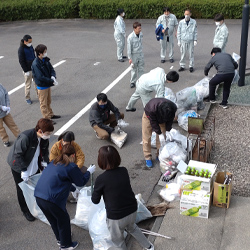
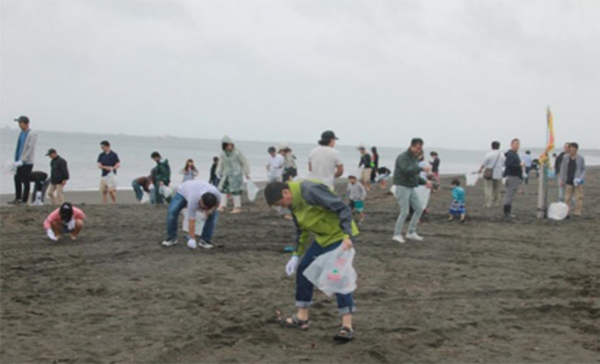
Cleaning activities
Giving on-site classes Project for Comprehensive Forestry Education
In October 2021, Sumitomo Forestry launched "morino de van," a comprehensive forestry education Giving on-site classes Project in collaboration with the Gifu Academy of Forest Science and Culture (morinos*). This project is an initiative to deliver diverse and comprehensive forest experiences using a Wald-car.
In May 2024, we participated in "Plaza to Make the Earth Smile" hosted by TOKYO BROADCASTING SYSTEM TELEVISION, INC. Under the theme "Let's Create the Town of the Future!" this initiative aimed to provide learning and hands-on experience about SDGs actions that can be taken for the future. Sumitomo Forestry provided the program mainly for children who have limited opportunities to interact with nature in their daily lives. It included "Barefoot Trail," where participants walked barefoot on wood and sand, "Touch and Feel Museum," where they could touch stuffed animals, and "Knock Knock Knock," where children could choose what they wanted to make from "Takara no Yama," a pile of wood chips (scrap wood), by creating things using tools such as hammers, saws, and nails. We hope that such experience will be an opportunity to think about SDGs to protect nature for a long time.
The program will aim to realize a society in which all people and forests are connected and "coexist" through the nature experience programs offered by the delivery of classes.
*Nickname of the Forestry Education Center within the Gifu Academy of Forest Science and Culture. Its purpose is to connect all people with forests and pass on the joy of living with forests and the richness of forest culture to the next generation
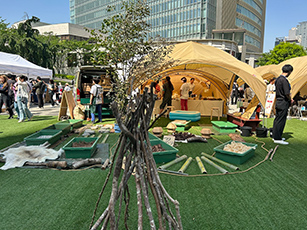
Scenes from Knock Knock Knock
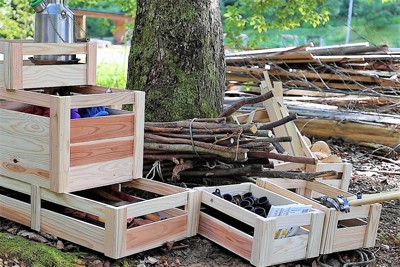
Barefoot Trail
Technology to Pass Down Heritage and Precious Trees to the Next Generation
Sumitomo Forestry uses the most cutting-edge biotechnology in addition to conventional grafting and cutting based on the request of owners to pass down heritage and precious wood to the next generation. This enables us to put our strength into breeding seedlings with the properties in the flowers and leaves of heritage and precious wood and pass them down both heritage and precious wood to the next generation. In addition, we are building a DNA database for trees to further advance a sophisticated program to identify individual varieties.
Kyoto Botanical Gardens Celebrates 100th Anniversary by Planting Saplings Propagated by Our Tissue Culture
Our company is participating in the 100th Anniversary Supporter Program of Kyoto Prefectural Botanical Gardens. In October 2024, we attended the commemorative tree-planting ceremony at the 100th anniversary of the opening of Kyoto Prefectural Botanical Gardens. Seedlings were planted of "Akebono Ume" from Hōkyō-ji Temple, which were propagated through grafting by the Forestry and Forest Products Research Institute, as were seedlings of "Beniwakonbai" from Kitano Tenmangū Shrine, "Taikō Shidarezakura" from Daigo-ji Temple, and "Omurozakura" from Ninna-ji Temple. All of them were propagated by our company from tissue culture. In the future, we will collaborate with Kyoto Prefecture and Kyoto Prefectural Botanical Gardens to propagate famous cherry and plum trees from within Kyoto Prefecture from tissue culture, and we will plant them in the newly established tree garden in Kyoto Prefectural Botanical Gardens. Even if the original famous trees were to die due to natural disasters, pests, or diseases, the seedlings planted in the tree garden will remain, thereby mitigating the risk of extinction. For the next 100 years, we will contribute to realizing the vision of Kyoto Botanical Gardens of "contributing to the conservation of the world's biodiversity from Kyoto" through the total coordination of trees, including the propagation of seedlings from the tissue culture of famous trees.
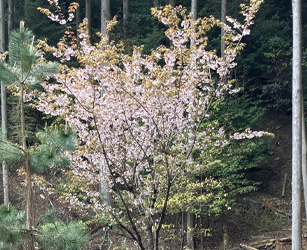
Commemorative Tree Planting Ceremony
Training and Education for the Next Generation
Cooperation with Niihama City Junior High Schools Hometown Study
Each junior high school in Niihama City conducts the Besshi Copper Mine Mountain Climbing (Hometown Study) to learn about the history and historical sites of the Besshi Copper Mine, which laid the foundation for Niihama's development, in order to understand local characteristics and enhance love for the local area.
At the request of the Board of Education, Sumitomo Forestry is helping junior high school students take a guided tour of the facilities at Forester House so that they can learn about the history of afforestation and get a sense of the green revitalized Besshi Copper Mine before climbing the mountain.
| May 2024 | Funaki Elementary School |
|---|---|
| May 2024 | Niihama City Board of Education On-site Training |
| May 2024 | Ohjoin Junior High School |
| June 2024 | Kita Junior High School |
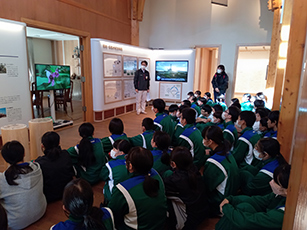
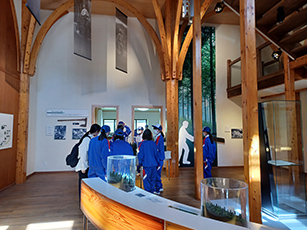
Training
Support for Social Contribution Activities of Other Companies
Supporting Tree-Planting Activities at BAUM Oak and Hinoki Forest
BAUM, a brand of Shiseido Co., Ltd. with the theme of "coexistence with trees," is engaged in efforts to recycle forest resources based on its brand philosophy of "not only receiving the blessings of trees but also returning them to nature."
Sumitomo Forestry has been supporting the brand's activities since June 2020 when BAUM was launched, by producing and maintaining saplings grown in the stores and further cultivating the saplings grown in the stores for tree planting.
At the "BAUM Oak Forest" in Morioka City, Iwate Prefecture, seedlings of oak (Mizunara) are planted to be used for the wooden parts of cosmetic packaging to promote the recycling of forest resources. Seedlings of oak (Mizunara) grown at BAUM stores are further cultivated at our Motoyama Tree Nursery Center until they reach a size suitable for planting. In the 2024 tree-planting activities, 600 seedlings were planted. As part of our environmental contribution activities, employees from the Housing Division supported the brand's initiatives by participating in tree planting.
We also support the activities at BAUM Hinoki Forest, which was established within a public forest in Niihama City, Ehime Prefecture. Based on the tripartite agreement signed in January 2024 between Shiseido, Niihama City in Ehime Prefecture and our company, the first tree-planting event in BAUM Hinoki Forest was held in May 2024.
At BAUM Hinoki Forest, Sumitomo Forestry supports the brand's efforts to recycle forest resources by producing, maintaining, and nurturing hinoki seedlings grown in stores and also supplying chips from Shikoku-grown Japanese cypress, which are used as raw materials for skincare products.
Niihama City is a place associated with the Sumitomo Forestry Group and where the management of forests surrounding the copper mines in Besshi Copper Mine was a starting point. The tree-planting activities are planned to be carried out over ten years starting from 2024, with approximately 600 hinoki seedlings grown in stores each year and then further cultivated at the Motoyama Tree Nursery Center.
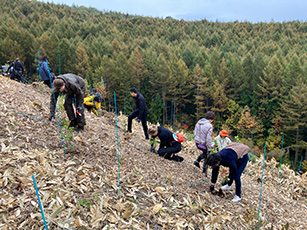
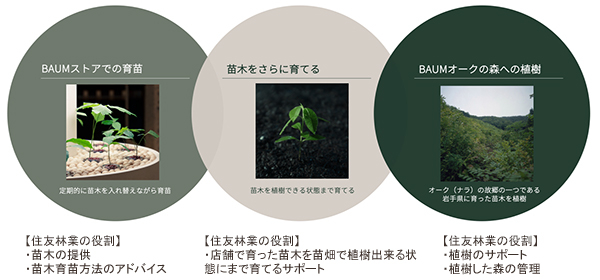
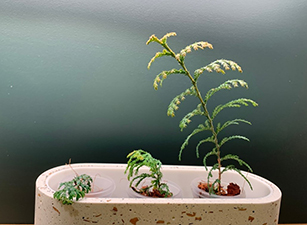

Tree Planting
Dissemination of SDGs
The Sumitomo Forestry Group believes that it is crucial to disseminate and foster an understanding of SDGs to contribute to the SDGs through business. We conduct various initiatives to raise awareness in not only our employees but all of our stakeholders (examples below).
Registration as a Company Promoting SDGs in Niihama City
The Niihama City SDGs Promotion Company Registration System that supports companies actively working to achieve the SDGs welcomed the Sumitomo Forestry Niihama General Administration Office as a member in February 2021.
In Niihama where the Sumitomo Forestry Group was founded, we will continue to advance activities to achieve the SDGs from encouraging the employment of people with disabilities and procuring plantation wood and certified timber which considers sustainability and biodiversity to creating public forest benefits through the management of company owned forests.
In 2023, in addition to the progress report submitted in March, a registration renewal application for the same system was submitted in November, and it was approved in March 2024.
Giving on-site classes at elementary schools in Niihama City
The Niihama City Board of Education is developing educational activities in collaboration with schools and local communities in order to nurture leaders of a sustainable society. In response to a request for cooperation in environmental education, Sumitomo Forestry visited each elementary school and held classes.
In the on-site classes, participants learned about the workings of trees and forests and their public benefits while introducing examples of Sumitomo Forestry's work and initiatives.
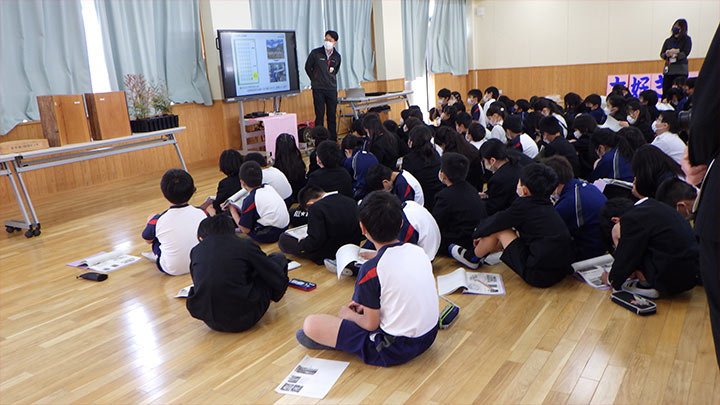
4th graders at Izumigawa Elementary School held in March 2022
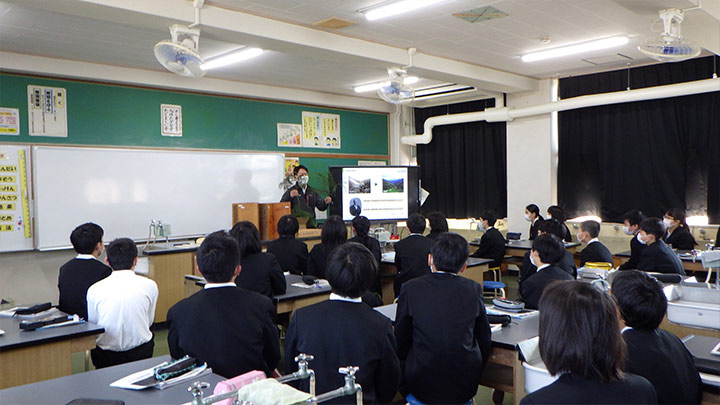
5th graders at Habu Elementary School held in March 2022
Registration as a Kanagawa SDGs Partner
The Kanagawa SDGs Partner program is a registration program to encourage cooperation in efforts between the prefecture and corporations and other entities working to achieve the SDGs in the prefecture. Sumitomo Forestry has been registered as a Kanagawa SDGs Partner on April 13, 2020. Broader standardization of ZEH to reduce greenhouse gas emissions aims to help combat climate change, energize the economy and bring greater environmental awareness.
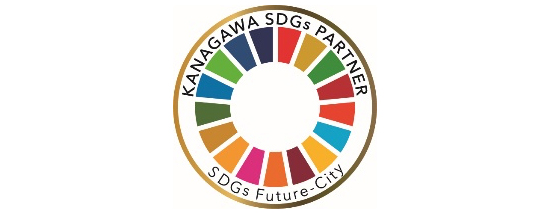
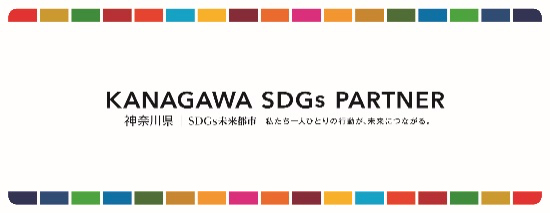
Kanagawa SDGs Partner Logo
Committing to the Shizuoka City SDGs Declaration
The Shizuoka Branch of the Housing Division at Sumitomo Forestry is committed to the Shizuoka City SDGs Declaration which has been encouraging SDG activities through offices and associations in Shizuoka City in addition to develop and broadly share excellent case studies since November 2019. As a target of initiatives, we have set an 80% standardization rate for Net Zero Energy Houses (ZEH).
- Click here for related information
Registered under the Maebashi City SDGs Partner Program
In November 2022, based on the philosophy of SDGs, the Gunma Branch of the Housing Division was registered in the "Maebashi City SDGs Partner Program" as a company, an organization, or the like that works together to solve regional issues and to create sustainable communities without leaving anyone behind, and stated that the Gunma Branch aims at 80% spread of ZEH in the action declaration for achieving SDGs.
Publication of Examples to the Educational "EduTown SDGs" Website for Elementary and Junior High School Students
Tokyo Shoseki provides educational materials on the educational EduTown: Let's Build Our Future website for the SDGs to inspire elementary and junior high school students to think about the future of our planet from a global perspective through each sustainable development goal and learn what they can do. This website also includes our activities since fiscal 2020 to foster circular forest resources by planting and using trees as an example for Goal 15 of the SDGs.
- Click here for related information
- Home
- Sustainability
- Social
- Social Contribution
- Examples of Social Contribution Activities in Japan

